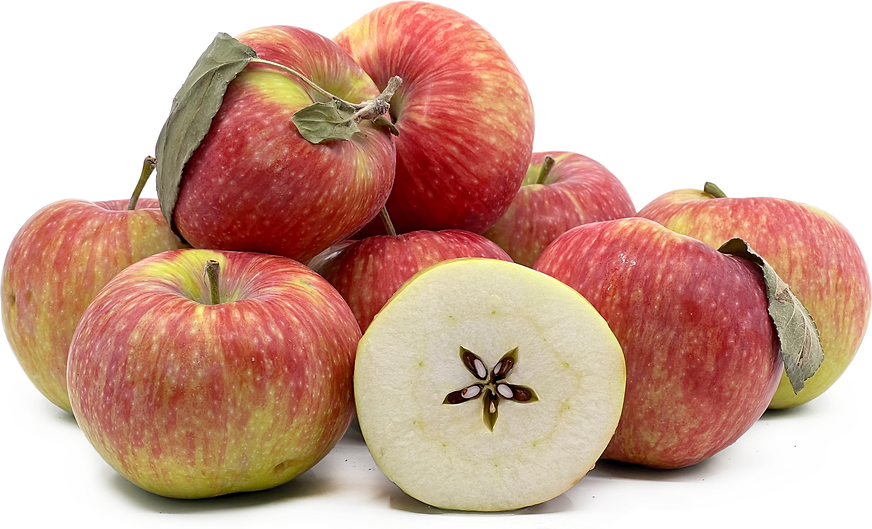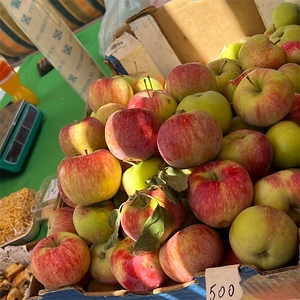


Melba Apples
Estimated Inventory, 1 Lb : 0
Description/Taste
Melba apples are medium to large fruits, averaging 8 to 9 centimeters in diameter, and have a round to conical, slightly flattened shape. The skin is lightly ribbed, smooth, semi-thin, and chewy with a yellow-green base, covered in dark red striping and blush. The skin also bears many white-grey lenticels and a waxy bloom, giving the surface a glossy, oily appearance. Underneath the skin, the flesh is firm, white with pale pink and green hues, crisp, aqueous, and fine-grained, encasing a central core filled with brown, oval seeds. Melba apples are aromatic with a scent likened to a blend of candy sweetness, strawberries, and caramel. The flesh is sweet, fruity, and tangy with subtle sour notes.
Seasons/Availability
Melba apples are available in the late summer through fall.
Current Facts
Melba apples, botanically classified as Malus domestica, are an all-purpose variety belonging to the Rosaceae family. The sweet, subtly sour fruits were introduced to commercial markets in the late 19th century and quickly became popular for their flavor, attractive appearance, and early-ripening nature. Melba apples are also known as Azure apples in Russia and are grown commercially in Canada, Europe, and Central Asia. In addition to commercial cultivation, the variety is frequently cultivated by apple enthusiasts in home gardens worldwide and is favored for its disease resistance, small size, and high yields, producing over 20 kg of fruit in a single season. Melba apples are also used by breeders in apple cultivation and have helped create more than 20 varieties of apples.
Nutritional Value
Melba apples are a good source of vitamin C, an antioxidant that protects the body against free radicals, which are molecules that can cause damage to cells and contribute to some diseases. The fruits are also a good source of fiber to cleanse the digestive tract and provide lower amounts of potassium, magnesium, calcium, and iron.
Applications
Melba apples are an all-purpose variety that can be treated as a dessert or cooking apple. When fresh, the fruits can be eaten with the skin on, or they can be peeled for a more delicate texture. The flesh can be sliced and tossed into green salads, quartered and served as a snack on appetizer platters with dips, or chopped into fruit bowls. Melba apples can also be pressed into juice for ciders, cocktails, smoothies, and fruit punches, and the variety is often used in industrial juice processing for its sweet-tart flavor. Beyond fresh preparations, Melba apples are well-suited for baked applications and can be incorporated into pies, tarts, strudels, muffins, and cakes, pureed into sauces, or baked with sugar as a dessert. The fruits can also be cooked into jellies, jams, and compotes, dried and eaten as a chewy snack, or canned in a simple syrup for extended use. Melba apples pair well with spices such as anise, nutmeg, cloves, and cinnamon, herbs such as rosemary, sage, mint, and parsley, roasted meats such as pork, poultry, turkey, and beef, and cheeses such as cheddar, brie, goat, and blue. Whole, unwashed Melba apples will keep for 1 to 2 months when stored in the crisper drawer of the refrigerator.
Ethnic/Cultural Info
Melba apples were named after the famous 19th-century opera singer Nellie Melba. It has been reported that apple breeder William Tyrrell Macoun was a fan of the Australian singer and named the variety in honor of the musician. Nellie Melba was considered one of the most famous operatic sopranos of the 19th and 20th centuries and primarily sang in performances throughout Europe, New York, and Australia. The Australian native created her stage name, Melba, after her hometown of Melbourne and was the first Australian to become an internationally famous musician. In addition to Melba apples being named after her stage name, Nellie Melba was close friends with famous French Chef Auguste Escoffier, inspiring other dishes to be named after the singer. Melba often ate at Escoffier’s restaurant in London, inviting Escoffier to her performances, and through their friendship, well-known dishes such as peach Melba, Melba toast, Melba garniture, and Melba sauce were created in honor of the singer. Peach Melba is still served at restaurants in the modern-day, and Nellie Melba is also featured on the Australian $100 note.
Geography/History
Melba apples were created in 1898 by apple breeder William Tyrrell Macoun at the Central Experimental Station in Ottawa, Canada. The variety was developed from a cross between a mcintosh apple and an unknown variety, with many experts hypothesizing that the variety may have been a liveland raspberry apple. Melba apples were released commercially in 1924 and introduced to Europe in the mid-20th century, where the variety saw commercial success. In 1947, Melba apples were included in the Soviet State Register and were a favored variety for commercial farms and home gardens. Today Melba apples are cultivated through farms and apple enthusiasts for sale at farmer's markets, specialty grocers, and supermarkets in the United States, Canada, Europe, and Central Asia.
Recipe Ideas
Recipes that include Melba Apples. One









